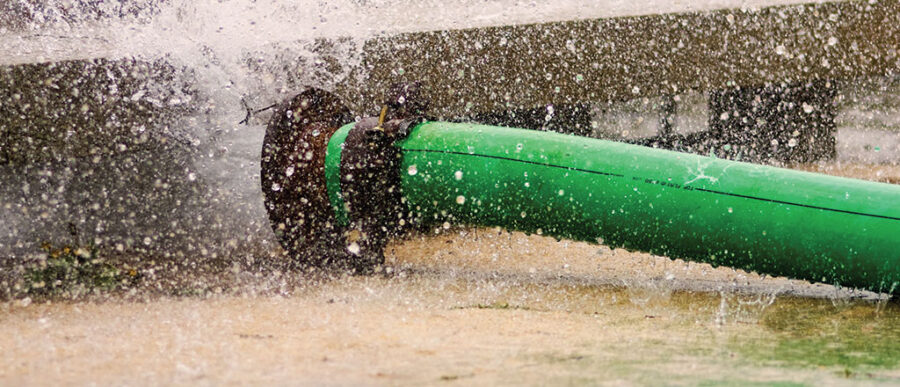Clean, safe drinking water has been available for so long in the U.S. that no one thinks twice about filling a glass of water at the kitchen sink or flushing a toilet. Indeed, for most people the shock would be if any of these conveniences failed to function. But the very longevity that has bred such faith in America’s water systems now threatens its future. Vast networks of underground pipes, often dating back to the 19th century, are nearing or are already past the end of their useful lives. But unless a water main breaks or a street caves in, it is all too easy to ignore the invisible infrastructure slowly crumbling beneath our feet.
Such emergencies are growing increasingly frequent. The American Society of Civil Engineers’ “2013 Report Card for America’s Infrastructure,” which gave the nation’s water infrastructure a “D+” grade, reveals that there are an estimated 240,000 water main breaks per year in the U.S. The Center for Neighborhood Technology in Chicago estimates that approximately 6 billion gallons of water could be wasted in the U.S. every day.
Less obvious but at least as troubling, is that 7 billion gallons of water are leaking out of aging pipes every year, said Patrick Cairo, senior vice president for corporate development at Suez Environnement. Water-issues site Growing Blue lists U.S. cities with the worst leakage problems between 2000 and 2010: Atlanta came up on top, with 31.4% of water lost, followed by Cleveland at 28.7%, Philadelphia at 26.5%, Pittsburgh at 26%, Detroit at 15.9% and New York City at 14.2%.
“The bottom line is that we’re not investing in our underground infrastructure,” said Cairo. “Hundreds of billions in water and sewer improvements are not being made.” As a result of this neglect, a million miles of underground pipes need to be replaced, according to a 2012 American Water Works Association (AWWA) report entitled “Buried No Longer: Confronting America’s Water Infrastructure Challenge.” The cost of repairing the existing damage and keeping up with ongoing maintenance is staggering. “Restoring existing water systems as they reach the end of their useful lives and expanding them to serve a growing population will cost at least $1 trillion over the next 25 years,” according to the AWWA report. Through 2050, the costs escalate to $1.7 trillion, or $30 billion annually. Looking at recent history, it is difficult to imagine municipalities shouldering this burden on their own.
How We Got Into This Mess
“The people who wrote the Clean Water Act made some very good choices,” said Richard Anderson, a senior advisor at the U.S. Conference of Mayors and managing director of the Mayors Water Council. One of the best aspects of the 1972 Act was that it “gave teeth to a federal agency to create a regulatory regime to force water quality improvements,” he noted at a recent Wharton conference, “Investing in America’s Public Water Systems — Making Public-Private Partnerships Work.” But the Act was also flawed, Anderson said. “It focused all the investment on the capital side — it was all for construction. And the systems have to be operated, not just built.” Anderson called this narrow focus “the single most important blunder” of the Clean Water Act, because “it created a mindset, which is now a legacy impediment to considering other types of models.”
Vast networks of underground pipes … are nearing or are already past the end of their useful lives.
The problem was that within 10 years, the majority of money that local governments were spending on water infrastructure was going to operation and maintenance. As a result, the repair and replacement of pipes and facilities were neglected. “We have a balkanized network of 58,000 water systems and 1,600 water treatment plants with three million miles of pipe, and it’s expensive to run it,” Anderson said.
Compounding this problem was the fact that Congress switched from grants — which funded up to 75% of water infrastructure — to loans, specifically state revolving funds. The change meant that local communities were now responsible for 100% of projects costs because they are required to repay the loans. The result was that some cities and town spiraled toward a water crisis.
Federal agencies can be of some help to municipalities with water problems, said Patrick Sabol, a senior policy and research assistant with the Metropolitan Policy Program at the Brookings Institution. However, in the U.S. it is a local endeavor with far less federal involvement than in neighboring Canada. And localities, with other funding priorities and not enough political buy-in, are hard pressed to come up with the revenue streams necessary to both operate and maintain their water systems.
Many experts also believe that municipal water systems have been systematically underfunded, in part because raising rates is unpopular politically, and elected officials often serve short terms. The result is a water-consuming public not accustomed to shouldering the full cost of the resource. The absence of pay-ins from consumers and other users is one reason many municipalities have turned to public-private partnership (P3) agreements.
“People think that water should be free. My response is that if you’re in Washington, D.C., you can go down to the Potomac with your bucket, carry the water home, treat it, and when you’re done figure out a way to dispose of it,” said Janet Kavinoky, executive director of transportation and infrastructure at the U.S. Chamber of Commerce. “It’s hard to convince people that these things cost money, which is why it’s hard to get investment in water infrastructure.”
Municipal water systems have been systematically underfunded, in part because raising rates is unpopular politically.
James Hagan, a former EPA official who is now a lecturer in the earth and environmental science department at the University of Pennsylvania, said at the Wharton conference that “nobody wants to pay for water — they see it as a basic human right. But as a cost-effective approach to public health, nothing beats water treatment.”
“The notion that there’s an inherent right to water makes investment challenging,” agreed Will Sarni, a director at Deloitte who had previously led the environmentally themed consulting company Domani.
Complicating all this is that municipal assets like the public water supply “have historically been defined along political lines, but political borders mean nothing in a global economy,” said Eric Orts, the director of Wharton’s Initiative for Global Environmental Leadership (IGEL) and a law professor at the University of Pennsylvania, at the conference. “With water, we have more than 50,000 separate municipal systems, and we need to look across these artificial borders created 200 years ago to make alliances. And that can mean redefining the intersection of the public and private sectors.”
To help fund the infrastructure upgrades now required, the AWWA report said that “the typical three-person family could see its drinking water bill increase as much as $550 per year above current needs.” That could be a bit of a shock to a nation accustomed to low water bills — typically less than $3.75 for every 1,000 gallons of delivered drinking water, AWWA said. The best way to avoid such shocks is to be proactive, Hagan said. As the deputy administrator for the District of Columbia Water Resources Management Administration in the early 1980s, Hagan said that taking a preventive maintenance approach to running water plants paid big dividends in the long term, with far fewer emergency main breaks. The more predictable approach was not popular with work crews that preferred the excitement and local press coverage that came from a “firefighter response” to sudden crises.
A Public Trust
To be sure, municipal water management by private companies in the U.S. is not a recent endeavor. Many cities and towns eventually reach crisis points with their water infrastructure, and this is often when public private partnerships are adopted. According to Tim Carden, managing director of the PFM Group, the largest U.S. public finance advisory firm, “public officials have too much on their plates, and that contributes to the deplorable state of public infrastructure. It can be difficult to assign priorities when highways and water systems are competing for funding.”
Jim Kennedy, a consultant and former mayor of Rahway, N.J. who served from 1991 to 2010, said that when he took office the city was under a cease-and-desist order to shut down the malfunctioning water utility. “There were 22 polluters in the system,” he said, “11 permitted and 11 not permitted.”
“The bottom line is that we’re not investing in our underground infrastructure.” –Patrick Cairo
Kennedy is clear about the cause of Rahway’s infrastructure problem. “Water policy was in the hands of the City Council and the representatives couldn’t muster the political fortitude to raise rates, which were among the lowest in New Jersey at that time,” he said.
Rahway’s decision to enter into a P3 with United Water, finalized in 1999, was unpopular with some locals and with advocacy groups such as Food & Water Watch, a national watchdog group, but Kennedy is convinced it was the right thing to do. “Without a doubt, I’m convinced of the value of public-private partnerships,” he said. “It’s been tremendous for the community, with more than $1 million per year in savings. The operation is simply more efficient. At one point the municipal water system had 40 employees; now it has 16 with better service.”
Critics say it isn’t that simple. “Responsible public ownership is the best way to ensure safe and affordable water service,” said Mary Grant, a researcher with Food & Water Watch. “Privatization is irresponsible, because it is abdicating control over a vital public resource.” The group also charges that the involvement of P3s leads to higher rates for consumers.
To be sure, municipal water management in the U.S. is a recent endeavor. “Private firms dominated U.S. water supply throughout most of the 19th century,” wrote Scott Masten, a business professor at the University of Michigan in a 2011 paper for the Journal of Law, Economics and Organization. There were 16 waterworks operating in the U.S. in 1800, and only one was public. Masten reports that by 1970, 80% were publicly operated. “Frictions between cities and private companies over system extensions and improvements played a significant role in the shift to municipal ownership,” he said.
The National Association of Water Companies reports that almost 73 million consumers — about a quarter of the U.S. population — are currently being served with help from a private company, so in some ways water is simply going back to its history. “Not every private provider has delivered on promises of reduced rates,” The Wall Street Journal said in a 2012 story. “But to governments strapped for cash, the option is seen as increasingly attractive.”



